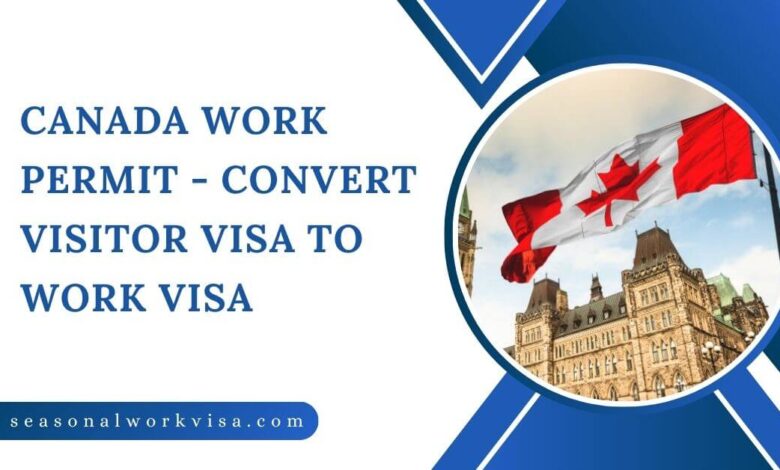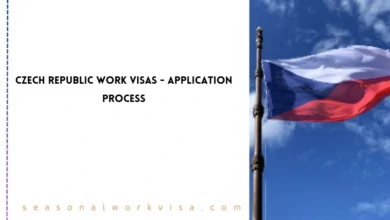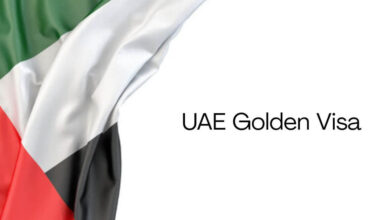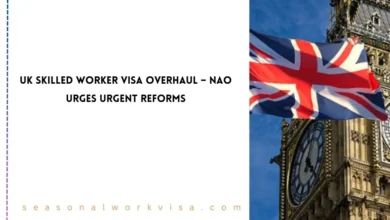Canada Work Permit 2025 – Convert Visitor Visa to Work Visa

It is essential to understand the intricacies and substances involved if you are contemplating traveling to Canada on a guest visa and subsequently converting it to a work permit. Although it is feasible to submit an employment application that is permissible from within Canada under specific circumstances, the process is not straightforward, and success is not guaranteed.
Canada’s dynamic culture and diverse attractions attract visitors from around the world. Numerous individuals briefly tour the country to explore its common excellence, participate in its rich heritage, or visit family members. However, the transition from a guest visa to a work permit presents potential benefits for individuals who wish to extend their stay for professional purposes.
This detailed examination delves into the intricacies of transitioning from a Canada guest visa to a work permit. We have obtained all the essential information, including the ability to comprehend the primary differences between these visas and the seamless preparation of the application.
Difference Between Visitor Visa And Work Visa
Initially, it is important to understand the difference between a work visa and a visitor visa in Canada.
- Tourist Visa: This visa is intended for individuals who require entry into Canada for tourism, leisure, or to visit family and friends. It is solely for non-work purposes. You are prohibited from working in Canada if you possess a visitor visa; it is essentially for transitory purposes.
- Work Visa (Work Allow): For individuals who require legal employment in Canada. Depending on the terms of your work visa, you are permitted to either work for a specific employer or operate as a self-employed individual.
If you satisfy specific requirements, you may renew your work visas. Additionally, you may apply for permanent residency or citizenship in Canada.
The process of converting a Canada guest visa to a work visa entails the preparation of specific reports that delineate the qualifications and expectations. These may encompass:
- Job Offer Letter: A formal letter of employment from a Canadian manager that delineates the position, responsibilities, and conditions of employment.
- Labor Market Impact Assessment (LMIA): In certain instances, managers may require an LMIA to demonstrate the necessity for external specialists and the inaccessibility of Canadian citizens or permanent residents.
- Proof of Capabilities: Reports that verify capabilities and significant work experiences, ensuring that they are by the job requirements.
- Valid Visa: A visa that is valid for a period exceeding the intended duration of stay in Canada.
- Proof of Reserves: Demonstrate financial stability to support oneself and any dependents while staying in Canada.
- Medical Examination: A medical examination may be necessary to ensure acceptance to Canada, depending on the duration of the stay and the country of origin.
Check Also: Canada 2-Year Temporary Work Permit – Apply Now
Eligibility:
To capitalize on this strategy, it is necessary to verify a few items on the qualification checklist:
- Valid Visitor Status: You are a lawful visitor in Canada.
- Job Offer in Hand: A Canadian manager has extended you an employment offer. This offer must either be Work Showcase Affect Appraisal (LMIA)-backed or LMIA-exempt.
- Valid Guest Status: Candidates must possess a substantial guest visa or be in Canada on the recommended status.
- Job promise: A genuine job promise from a Canadian employer who is willing to provide support for the work permit application.
- Adherence to Migration Laws: Compliance with Canadian movement laws and controls, including tolerability criteria.
Steps to Change over Canada Visit Visa to Work Permit:
The conventional methods for converting a traveler visa into a work permit include:
- Submit an application for employment in Canada: Initially, it is imperative to obtain employment that necessitates a Canadian work permit. Additionally, obtain a job offer from a Canadian manager who is willing to support the work permit application.
- Obtain an Endorsed Offer Letter with LMIA (Work Advertise Affect Assessment): The company that is advertising the work must possess an LMIA endorsement, which indicates that they are authorized to hire external workers.
- Gather Essential Documentation: As previously mentioned, compile the desired records, ensuring that they are authentic and valid.
- Apply for the Work Allowance: Apply for the work permit after you have secured the job and gathered the necessary archives.
- You have the option to submit a paper application at a Visa Application Center (VAC) or complete the application online through the Migration, Displaced People, and Citizenship Canada (IRCC) website.
- Individuals can convert their guest visa to a work permit in certain situations without undergoing the standard Work Advertisement Impact Assessment (LMIA) procedure.
- This alternative is particularly relevant for specific categories, such as the Worldwide Versatility Program (Pixie), which provides workers with opportunities for occupational advancement across borders.
- The LMIA exemptions within the Pixie system are designed to simplify the process for qualified individuals, eliminating the need for a comprehensive labor advertisement investigation.
- These exclusions are frequently justified by complementary understandings between Canada and other nations, global assertions, or other critical considerations that promote financial development and cooperation.
- Qualified individuals can consistently transition from visitor status to a work permit by utilizing these exceptions, thereby enabling them to contribute their abilities and skills to the Canadian workforce without the authoritative burden of an LMIA assessment.
- To ensure a successful conversion of their guest visa to a work permit, applicants must obtain the specific qualification criteria and documentation requirements associated with LMIA exemptions under the Universal Versatility Program.
If you are unfamiliar with the requirements for a working occasion visa in Canada, we recommend that you visit our official website for detailed information.
Conclusion:
The brief approach expansion may serve as an incentive to transition from a guest visa to a work permit in Canada. Candidates can investigate this journey with assurance and clarity by comprehending the qualification criteria, structuring the essential records, and following the predetermined procedures.
It is important to remember that counseling with authorized migration experts can provide personalized assistance that is tailored to your unique circumstances, thereby guaranteeing a seamless transition into the Canadian workforce.
Frequently Asked Questions:
How can I apply for a Canada work permit?
To apply for a work permit, most candidates will require a Canadian job offer supported by a Labour Market Impact Assessment (LMIA). There are some exceptions to this requirement, where foreign workers can apply for a work permit without an LMIA or a job offer.
Can I convert a visitor visa to a work permit in Canada?
Yes, under certain circumstances, you can convert your visitor visa to a work permit while in Canada. However, you need to meet specific requirements and follow the appropriate legal process.
Is IELTS mandatory in Canada?
IELTS is accepted by Immigration, Refugees, and Citizenship Canada (IRCC) as evidence of English language proficiency. If you are applying to study at the undergraduate or postgraduate level in Canada, you will likely be required to present your IELTS result as part of your application.




